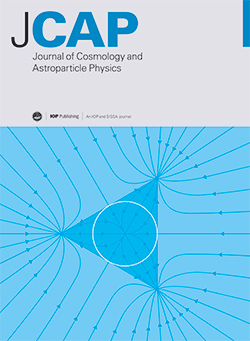低能超新星不育中微子的边界
IF 5.3
2区 物理与天体物理
Q1 ASTRONOMY & ASTROPHYSICS
Journal of Cosmology and Astroparticle Physics
Pub Date : 2025-03-21
DOI:10.1088/1475-7516/2025/03/052
引用次数: 0
摘要
不育中微子可以通过与核坍缩超新星(SN)炽热致密内核中的有源中微子混合而产生。SN产生的有源中微子-无源中微子混合(sin2θ)的标准约束来自SN1987A的能量损失,要求Eloss < 1052 erg。在这项工作中,我们讨论了不育中微子参数空间的一个新约束,它是由不育中微子在SN包层内的衰变所产生的能量沉积引起的。利用观测到的发光不足的SN IIP种群,这种能量沉积被约束为低于 ∼ 1050 erg。如果只关注与tau中微子混合的不育中微子,对于100-500MeV范围内的重不育质量ms,我们发现sin2θτ的严格约束比SN1987A能量损失论证的约束低两个数量级,从而探测到I型跷跷板机制所需的混合角。类似的约束也适用于只与μ介子的无菌混合(sin2θμ)。本文章由计算机程序翻译,如有差异,请以英文原文为准。
Low-energy supernovae bounds on sterile neutrinos
Sterile neutrinos can be produced through mixing with active neutrinos in the hot, dense core of a core-collapse supernova (SN). The standard bounds on the active-sterile mixing (sin2θ) from SN arise from SN1987A energy-loss, requiring Eloss < 1052 erg. In this work, we discuss a novel bound on sterile neutrino parameter space arising from the energy deposition through its decays inside the SN envelope. Using the observed underluminous SN IIP population, this energy deposition is constrained to be below ∼ 1050 erg. Focusing on sterile neutrino mixing only with tau neutrino, for heavy sterile masses ms in the range 100 – 500 MeV, we find stringent constraints on sin2θτ reaching two orders of magnitude lower than those from the SN1987A energy loss argument, thereby probing the mixing angles required for Type-I seesaw mechanism. Similar bounds will also be applicable to sterile mixing only with muons (sin2θμ).
求助全文
通过发布文献求助,成功后即可免费获取论文全文。
去求助
来源期刊

Journal of Cosmology and Astroparticle Physics
地学天文-天文与天体物理
CiteScore
10.20
自引率
23.40%
发文量
632
审稿时长
1 months
期刊介绍:
Journal of Cosmology and Astroparticle Physics (JCAP) encompasses theoretical, observational and experimental areas as well as computation and simulation. The journal covers the latest developments in the theory of all fundamental interactions and their cosmological implications (e.g. M-theory and cosmology, brane cosmology). JCAP''s coverage also includes topics such as formation, dynamics and clustering of galaxies, pre-galactic star formation, x-ray astronomy, radio astronomy, gravitational lensing, active galactic nuclei, intergalactic and interstellar matter.
 求助内容:
求助内容: 应助结果提醒方式:
应助结果提醒方式:


